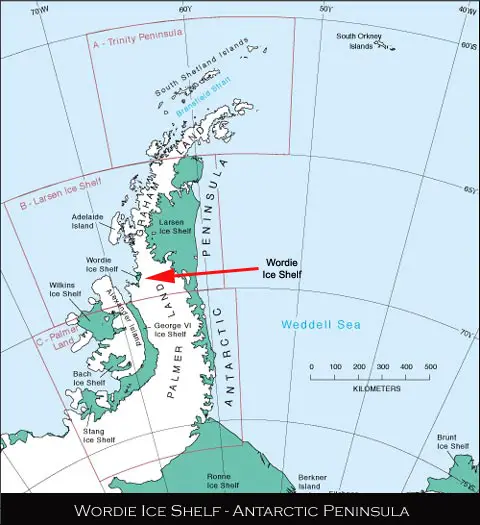The small Antarctic Wordie Ice Shelf on the southwest side of the Antarctic Peninsula has experienced a major retreat since the late 1940s. Scientists have analysed images of the Wordie Ice Shelf taken from 1974 and 1979. These images have recorded that the ice front retreated up to 7 km during this period, and the ice shelf itself has reduced in area by 250 km2. Since the collapse of the ice shelf in the late 1980s the area has been monitored closely.
Observations reveal that the glaciers flowing into former Antarctic Wordie Ice Shelf area are now moving at a much faster rate. For instance, the Fleming Glacier flows 50 percent faster than it did in 1974 prior to the main collapse of Antarctic Wordie Ice Shelf. British scientists have concluded that the glaciers accelerated following ice shelf removal, and have been thinning and losing mass to the ocean ever since.
The floating edges of ice shelves and outlet glaciers, are the most dynamic and changeable features in the coastal regions of Antarctica. The British Antarctic Survey reports that around 8,000 km2 has been lost since the 1950’s. Seven ice shelves on the Antarctic Peninsula have shown significant, progressive, and continued retreat. The Wordie Ice Shelf, Müller Ice Shelf, George VI Ice Shelf, and Wilkins Ice Shelf have all retreated. On the east coast, the ice shelves that occupied Prince Gustav Channel and Larsen Inlet and Larsen Ice Shelf A, have also retreated.
The average air temperature over the Antarctic Peninsula, which is a finger of land in the west jutting out toward South America, has risen 2.5° C in the last 50 years, much more rapidly than the rest of the world. The highly variable climate of the region is sensitive to the amount of winter sea ice. This frozen sea water forms around the Peninsula in autumn and mostly melts in summer. Average annual temperatures have now increased to -3° C, plant life is exploding, and vegetation is reported to have increased twenty five fold.

The collapse of ice shelves and rising temperatures can be linked, and there exists a climatic limit of viability for ice shelves related to summer temperatures. Warming has pushed the limit south and all the ice shelves that are now outside it have retreated, including the Antarctic Wordie Ice Shelf, the ice shelf that occupied Prince Gustav Channel, and Larsen Ice Shelf A. The final stages of the loss of Larsen Ice Shelf A in 1995 were particularly spectacular; in fifty days 2,000 square kilometres broke up into thousands of football pitch-sized icebergs and floated away. Although large iceberg calving events are routine for ice shelves, sudden disintegration is like this are not.
While ice shelves are not a direct influence on sea level because they are already floating, it has been argued that the Ross and Ronne-Filchner ice shelves help to stabilise the ice sheet in West Antarctica and so indirectly help to control sea level. The ice shelves act as a sort of plug, stopping the ice sheets from flowing into and breaking up in the sea, which would raise sea levels significantly. However, scientists are still unsure if the ice sheet would collapse if these ice shelves retreated. A total loss of the West Antarctic ice sheet would raise sea level by an average of 6m.
See Also
